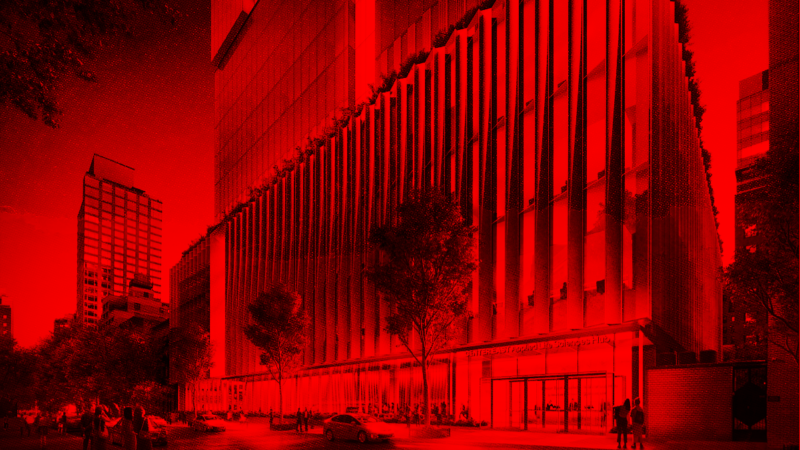New York NIMBYs Protest the 'Manhattanization' of Manhattan
The New York Blood Center wants a larger headquarters to continue its cutting-edge medical research. Activists claim the new building will cast too much shadow.

Sunday was bright and hot in New York City. So much so that a crowd of roughly 250 Manhattan anti-development activists, out to protest the shadows a new office tower would cast, were forced to huddle in the shade.
Slightly ironic visuals as the folks protesting the shade-casting tower are forced into the shade by the 90-degree heat pic.twitter.com/4hr0quvCW3
— Nick Garber (@nick_garber) May 23, 2021
The target of the protest was a proposal from the New York Blood Center—a nonprofit biomedical research group—to redevelop its existing three-story headquarters in the Upper East Side into a 16-story, 334-foot tower called Center East.
The Blood Center has said that its current building—a former trade school built in the 1930s—isn't suitable for modern biomedical research, necessitating a new facility. The expanded square footage of the proposed tower would allow easier collaboration between the center (which would occupy only about a third of the building) and other life science researchers.
The project would "provide 600,000 square feet of state-of-the-art space for institutions and biotech companies to collaborate in the heart of the city's most dynamic cluster of research and health institutions," wrote Jay Mohr, the Blood Center's chief financial and business officer, in an April op-ed for Crain's New York Business. He added that just .5 percent of the city's office space is currently devoted to the life sciences.
Nevertheless, the size of the proposed project—and the zoning changes required to facilitate its development—have some activists out for blood. A collection of Upper East Side neighborhood and preservation groups have joined forces to form the Coalition to Stop the Blood Center, which organized Sunday's protest.
"The 334-foot-tall building has floor plates the size of the Empire State Building and would be 4.5 times taller than the 75-foot height limit allowed by zoning—zoning that was designed to preserve access to light and air, especially given the location directly across from St. Catherine's Park," says the Friends of the Upper East Side Historical Districts, one group opposing the project.
A 41-page shadow study prepared for the city found that Center East would cast an additional three to four hours of afternoon shadow on St. Catherine's Park during the spring, summer, and fall.
Project opponents also worry that the rezoning could set a "dangerous precedent" for future overdevelopment. Should this project be allowed, apparently, tall buildings might soon spring up all over New York City.
Activists have also expressed concern that the building would contain biosafety level 3 (BSL-3) lab space.
"BSL-3 laboratories are considered high-containment research laboratories that are intended for the study of highly infectious pathogens," wrote Manhattan Borough President Gale Brewer in a February letter. "The fact that the proposed facility is in a residential neighborhood raises serious questions about the adequacy of safeguards and the potential impact of such a laboratory."
As Curbed notes, a number of BSL-3 facilities already exist in the neighborhood, including at the existing Blood Center building.
The project has attracted a number of high-profile critics, including Rep. Carolyn Maloney (D–N.Y.), state Sen. Liz Kueger (D–New York City), and New York City Council Member Ben Kallos.
It's "the middle of a residential neighborhood. It's out of scale. It's not needed. Sixty percent of it is commercial, not for Blood Center use," Maloney said in a short video she shot on her way to Sunday's rally. "It's another fight to preserve our zoning, preserve the character of our neighborhood."
This opposition could make life difficult for the Center East project as it works its way through the city's arduous Uniform Land Use Review Procedure.
This months-long process, which is required for the kinds of zoning changes the Blood Center is seeking, allows multiple city bodies to weigh in, including the city planning commission and the city council. A final vote from the city council is expected by the end of the year, reports Patch.
But not everyone hates the idea of permitting a new hub for innovative medical research.
"The proposal before us seeks to modernize critically important but more than 50-year-old life-giving institution," said Marisa Lago, chairperson of the city planning commission, at a meeting in April. "This project connects researchers and world-renowned academic health and medical institutions, unlocking space needed to grow these symbiotic relationships."
Center East opponents claim that the Blood Center could reap these benefits by moving into vacant lab space elsewhere in the city. But Sujit Sheth, chief of the Division of Pediatric Hematology and Oncology at the nearby Weil Cornell Medical School, argues that the current location of the Blood Center is crucial to its work.
"The physical location of the New York Blood Center in this hub of medical and scientific institutions is key to the continuity of so many research, educational and clinical programs," he said in a letter supporting the project. "If the Center were forced to move away, it would create a void that we would not be able to fill at all."
Activists around the country often raise the specter of "Manhattanization" when opposing a project they consider too large for their particular backyard. Apparently, anti-development activists in Manhattan have the same concerns.
A new building that facilitates cutting-edge, life-extending medical research seems like a nice thing to have in a neighborhood, even if it also means a more shaded park. Manhattanites who don't like the idea of a really tall building next door always have the option of living literally anywhere else in the country.
Rent Free is a weekly newsletter from Christian Britschgi on urbanism and the fight for less regulation, more housing, more property rights, and more freedom in America's cities.


Show Comments (29)